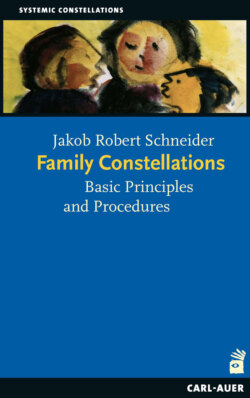Читать книгу Family Constellations - Jakob R Schneider - Страница 13
На сайте Литреса книга снята с продажи.
What happens in a constellation?
Оглавление•It begins with an issue, or a need, or the client’s desperate search for resolution. The “weight” of the issue is what carries the entire constellation. The way the client formulates the issue and the accompanying gestures provide the first important information for the therapist, and the therapist’s first accurate feedback in response to the “energy” of the client usually creates a basis of trust for the process to follow.
•A few brief questions establish the “field” of the constellation, that is, the persons that will be represented, and the dynamics of the psychic relationships that seem to be involved.
•As many representatives are placed in the field as seems necessary for a starting point, at least one person, but more usually two or more. There may also be representatives of symptoms, feelings, secrets, death, war, countries, or other abstractions.
•When positioned, the representatives open themselves up to the forces operating within the field and express, physically or with words, whatever they are aware of. There may be a fluid exchange between free movements and spontaneous statements, and expressions guided by the therapist.
•These movements may lead naturally to a resolving step that is ripe for expression, for example, an embrace for a mother or daughter following a long-standing animosity. Or, the therapist might follow an inner image or some feeling about what is called for, and may guide a representative in a particular movement or to a new position to check out the reactions of the representatives and the client.
•The therapist may intervene by asking the client additional questions, which could prompt changes in the representatives’ positions or the addition of new representatives. He or she may initiate a ritual, such as bowing down, or provide sentences that make the bonds within the system clear, or sentences of resolution. The therapist may arrange the constellation into an image of resolution in order to provide a new orientation and a place for everyone in this relationship system.
•Occasionally, a constellation needs to be broken off because the representatives have become very confused or cannot feel their way into the system, or because all movement stagnates and no new information is forthcoming. Sometimes, we stop because a client is unable to feel anything or make any connection with the constellation.
•When it seems necessary for clarity and understanding for the client and the group, the representatives may be asked for additional comments after the constellation, or the therapist might comment upon some aspect of what has happened.
•The therapist can check out his or her sense of what is going on by asking the client directly for a reaction. If it is useful, there can be a follow-up intervention, such as a guided fantasy that picks up on cues from the constellation and provides the resolving step. “Close your eyes and imagine your mother. Look at her and tell her…” or, “imagine your father…”
•If a constellation does not give the client something new, as a rule we cannot expect it to have any effect.
•Generally, this is the end of the “help” for the client, but there are many exceptions. There may be individual follow-up sessions, additional group constellations, letters, or telephone consultations. The actual process of resolution is reflected in the client’s behaviour following the constellation and in real changes that occur in the person’s state and in relationship systems.
In Chapter 4, I will provide a more detailed description of this method of working, but for anyone learning the approach and trying to understand the many facets of the process, it would, of course, be useful to experience many constellations, perhaps in an advanced training programme. The literature list at the end of this book offers additional resources.
Here, I only mean to make clear that constellations with representatives proceed simply and intensively on their own, without any instructions to the representatives (for instance, we do not tell them to hold hands, or kneel down, or stand on a chair). Such movements may occur in a constellation but only when they evolve from the representatives’ feelings. Then, the movements carry weight and conviction because they reflect something that belongs to the relationship system or the client. It should also be clear here that a constellation constructs itself from the factual events and fates in a family, with the help of minimal interventions by a therapist.
What is most important is that constellations can show us, in a new, convincing form, how the fate of others in our relationship network affects us and creates problems, and how forces for change can be awakened through insight into previously unconscious processes. The therapist cannot plan any of this in advance. The therapist, the representatives, and the client all enter into a process without preconceptions, intentions, expectations, fear, or well-intended protectiveness. It is a process whose outcome cannot be seen in advance but one that is aimed towards an unknown resolution. Whether representatives are free to move spontaneously or whether the therapist intervenes with an image or hypothesis, the focus always remains on the effects, which then dictate the next step. Whether it is more appropriate to allow the representatives to move freely or for the therapist to guide them, depends on the observable, felt effects on the client. These effects, however, do not remain static, but immediately become part of a multi-layered process, the interplay between setting one’s life course and having it set by events and dynamics beyond one’s control. When a constellation helps, the effects set a course towards changes that can bring resolution.
